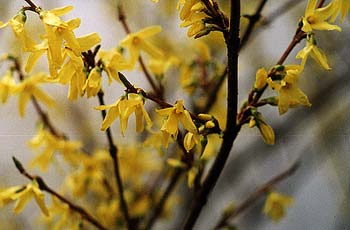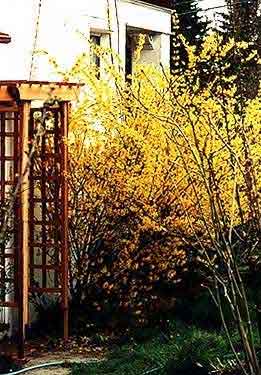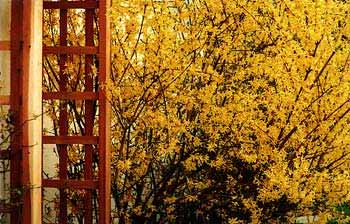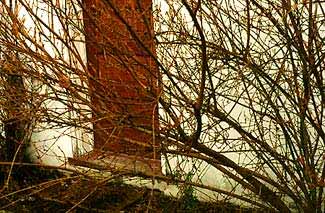 | |
| A late March close-up of the forsythia in fullest bloom. This large shrub is often called Golden Bells because of the hanging blossoms. It begins flowering in February & is in full sway in April, when the second & third photos below were taken. | |
A Fountain of Golden Bells,
Forsythia intermedia
This huge Forsythia intermedia reaches away from the wall & in the way of the path, but I certainly don't mind. The bulk of the bush is about ten feet by ten feet, but a few far-reaching longer limbs sweep from the house to the fenceline, so that I have to lift up or duck under three or four limbs when I walk that direction. I've gotten so used to ducking it doesn't bother me; it's worth it for the unpruned look. I keep trying to picture an enormous arbor or pergola that'd clear the path & not look oddly located so that I needn't so often have to make the choice between pruning the longest limbs, or relying on the ducking-under system.
Border Forsythia is a hybrid that gets its fountaining nature from F. suspensa which is the Weeping Forsythia , which also provides F. intermedia it's yellowish bark & its large size.
 From being crossed with F. virridisima, it gains the habit of a very large number of early blooms in brightest yellow, plus an occasional bronzy cast to the leaves, & this part of the Border Forsythia's heritage is what slightly straightens out the branches so that they fountain at a long angle, rather than weep close to the bush as with the true Weeping Forsythia.
From being crossed with F. virridisima, it gains the habit of a very large number of early blooms in brightest yellow, plus an occasional bronzy cast to the leaves, & this part of the Border Forsythia's heritage is what slightly straightens out the branches so that they fountain at a long angle, rather than weep close to the bush as with the true Weeping Forsythia.There are many cultivars of this hybrid, with differing characteristics from dwarfed, to giant, to erect limbs, to variegated leaves. I feel like we inherited the ideal Border Forsythia in having a basic fountaining giant form.
Forsythia bears the name of the Englishman William Forsyth, who in the later part of the 1700s built the first English rock garden using lava rock brought from Iceland & stone blocks from the Tower of London.
F. intermedia blooms before it leafs out at the very earliest sign of Spring. The full-flower portraits on this page were taken on two different days in March. It is rare that forsythia reblooms or blooms out of season, but I was amused when ours unexpectedly had a few random blooms on it in October!
One oft-repeated & entertaining recommendation with Forsythia is to "force" winter flowers from the buds indoors. Clip a choice limb or two & place those in a vase of water in a sunny window. This will give butter-yellow blooms for late winter, a couple weeks before the buds open on the actual shrub outdoors. It has additionally been noted how it is that frequently the cut branches will develop roots; you could pot these & end up with young shrubs to give as gifts.
 Though fast-growing to replace cut or pruned branches, therefore easily used for bouquets, it should otherwise be left to get as big as it wants to get, in order to achieve its ideal fountaining appearance. If in time some old branches seem untidy, or the shrub is getting so tightly limbed from constantly producing new branches that it no longer shows to advantage, then some of the older limbs can be thinned down to the base. But don't be hasty about pruning. Stumpy forsythias just aren't as nice as those with limbs that arch delicately. If it's never pruned at all, it may eventually produce fewer blooms, concentrating its energies on leafing out & maintaining an excessive density, but pruned too often, the distinctive character of the limbs is destroyed.
Though fast-growing to replace cut or pruned branches, therefore easily used for bouquets, it should otherwise be left to get as big as it wants to get, in order to achieve its ideal fountaining appearance. If in time some old branches seem untidy, or the shrub is getting so tightly limbed from constantly producing new branches that it no longer shows to advantage, then some of the older limbs can be thinned down to the base. But don't be hasty about pruning. Stumpy forsythias just aren't as nice as those with limbs that arch delicately. If it's never pruned at all, it may eventually produce fewer blooms, concentrating its energies on leafing out & maintaining an excessive density, but pruned too often, the distinctive character of the limbs is destroyed. When one hears the recommendation to prune shortly after the flowers begin to wilt, this should not be taken as a requirement & certainly not an annual requirement. Perhaps every three or four years at most & then with restraint. It is just as well to prune in late Autumn, but it is easiest to judge which limbs are newest in spring; first-year limbs won't yet have flowered & it's easier to avoid getting the young growth if you can see which limbs are flowerless.
It is occasionally mistated that old limbs stop blooming; this is certainly not so on ours. Second year branches & fourth year branches are all blooming with equal ferocity. When it does seem time to thin out a bush, cut unwanted limbs to within a few inches of the root's crown, avoiding first-year limbs, but always saving enough of the oldest limbs to retain the bush's sweeping substantiality.
 Some have said Forsythia isn't that interesting outside of bright blooming early spring, but they must've been looking at stumpy pruned ones without the arching finely leafed branches. The bright green foliage will last until very late in autumn; ours turns a pleasing rust-red & bronze around late September & October, then in November it puts on an incredible show of bright yellow leaves, which you can see in the Autumn Leaf Gallery's Forsythia Page. Plus, even the naked branches of winter are prettily yellow. A February portrait last on this page, which might be titled "Side Door To House, Through Yellow Branches," was taken before we built a trellising arbor around that door (see also the (Forsythia Page along the garden walk of winter barks).
Some have said Forsythia isn't that interesting outside of bright blooming early spring, but they must've been looking at stumpy pruned ones without the arching finely leafed branches. The bright green foliage will last until very late in autumn; ours turns a pleasing rust-red & bronze around late September & October, then in November it puts on an incredible show of bright yellow leaves, which you can see in the Autumn Leaf Gallery's Forsythia Page. Plus, even the naked branches of winter are prettily yellow. A February portrait last on this page, which might be titled "Side Door To House, Through Yellow Branches," was taken before we built a trellising arbor around that door (see also the (Forsythia Page along the garden walk of winter barks).The other criticism is that this shrub is just too common (though in our area lilacs & rhodies are much more common & no one should cut back on those either). The reason so many people have forsythia is because it's such a wonderful plant. They are forgiving of a wide variety of soil conditions & harsh weather, though the Northwest's mildness & rain & acidic humousy soils really are what it likes the most.
Western gardeners grow the shrub exclusively as an ornamental, but in China F. suspensa is used for culinary & medicinal purposes; & the garden hybrid makes a reasonable stand-in for the true species shrub. The yellow flowers are edible, used as garnish, though more for appearance than taste (they are somewhat bitter), & the tenderest young leaves are useful in salads & especially in soups.
The unripe fruit & seeds are crushed for use as an herbal medicine called lian qiao. Chinese herbalists recommend it for chills, fevers, headaches, & to help expel toxins from the body, the premise being that cleansing occurs by inducing farting. It is used topically for burns, infected injuries, carbuncles, rashes, & blemishes, some of the same uses long assumed in North America for a bark-extract of witchhazel.
In the absence of serious clinical trials, efficacy should be regarded at best debatable, though by no means improbable. A 1982 Japanese lab test, conducted by Nishibe et al in Tokyo, isolated the chemical component suspensaside from the crude Chinese drug, & found that it had a legitimate antibacterial action; this finding has been confirmed by later researchers. Another lab study conducted in 2001 by Rouf et al in Bangaladesh showed anti-inflammatory properties for the seed extract. This too is confirmed by several other researchers. A study by Schinella et al conducted in 2002 in Argentina showed an antioxidant function for the seed extract which was believed to explain the antibacterial properties of some of the chemical components.
Many similar laboratory analyses have provided suggestive results, but other studies, such as a 1991 mouse study by Yin et al in the Peoples Republic of China, indicate the chemical components of forsythia may be mutagenic, i.e., potentially cancer-causing. But no actual double-blind clinical trials have been conducted, so that the usefulness or harmfulness of lian qiao remains to be proven.